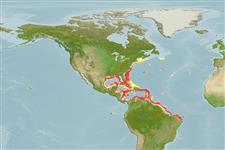>
Pleuronectiformes (Flatfishes) >
Poecilopsettidae (Bigeye flounders)
Etymology: Poecilopsetta: Greek, poikilos = with a lot of colours + Greek, psetta = grouper (Ref. 45335).
Eponymy: Tarleton Hoffman Bean (1846–1916) was an American ichthyologist and elder brother of B A Bean who was also an ichthyologist. [...] (Ref. 128868), visit book page.
More on author: Goode.
Environment: milieu / climate zone / depth range / distribution range
पारिस्थितिकी
समुद्री बाथीड़िमरसल; गहराई सीमा 155 - 1636 m (Ref. 57192), usually 200 - ? m (Ref. 57192). Deep-water; 45°N - 8°S, 98°W - 33°W
Western Atlantic: New England, USA south through the Gulf of Mexico to Campeche, Mexico; off the Central American coast to northern Colombia and northern Brazil; Cuba and St. Kitts.
आकार / वज़न / Age
Maturity: Lm ? range ? - ? cm
Max length : 10.7 cm SL पुल्लिंग / अलिंग; (Ref. 36347); 9.9 cm SL (female)
Short description
पहचान कुंजी | आकृति विज्ञान | मौरफोमैटरिक्स
Head small, compressed (19.1-20.1% SL).
Found along the outer continental shelf and slope (Ref. 57192).
Life cycle and mating behavior
परिपक्व अवधि | पुनरुत्पत्ति | मछलीऔ का अंडे देना | अंडे | Fecundity | लार्वा
Munroe, T.A., 2003. Poecilopsettidae. Righteye flounders. p. 1922-1924. In K.E. Carpenter (ed.) FAO species identification guide for fishery purposes. The living marine resources of the Western Central Atlantic. Vol. 3: Bony fishes part 2 (Opistognathidae to Molidae), sea turtles and marine mammals. (Ref. 57192)
IUCN Red List Status (Ref. 130435: Version 2024-1)
Threat to humans
Harmless
Human uses
मात्स्यिकी: कोई रुचि बग़ैर
साधन
Special reports
Download XML
इंटरनेट स्रोत
Estimates based on models
Preferred temperature (Ref.
123201): 6.2 - 19, mean 11.4 °C (based on 253 cells).
Phylogenetic diversity index (Ref.
82804): PD
50 = 0.5000 [Uniqueness, from 0.5 = low to 2.0 = high].
Bayesian length-weight: a=0.01995 (0.00906 - 0.04395), b=3.01 (2.83 - 3.19), in cm total length, based on all LWR estimates for this body shape (Ref.
93245).
Trophic level (Ref.
69278): 3.4 ±0.4 se; based on size and trophs of closest relatives
Fishing Vulnerability (Ref.
59153): Low vulnerability (10 of 100).
